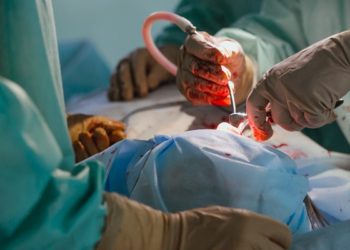Vancomycin and cefazolin not superior to cefazolin alone in arthroplasty prophylaxis
1. In this randomized controlled trial, the combination of vancomycin with cefazolin was not superior to surgical antimicrobial prophylaxis with cefazolin alone in patients undergoing arthroplasty.
2. Prophylaxis with vancomycin and cefazolin was associated with an increased risk of hypersensitivity reactions and decreased risk of acute kidney injury (AKI) compared to cefazolin alone.
Evidence Rating Level: 1 (Excellent)
Study Rundown: The prevalence of knee and hip arthroplasty continues to increase in the United States. Current practice recommends the administration of a first-generation or second-generation cephalosporin, such as cefazolin, prior to arthroplasty to reduce the risk of surgical-site infections. However, such antimicrobials may not prevent infections caused by methicillin-resistant Staphylococcus aureus (MRSA) or methicillin-resistant Staphylococcus epidermidis, increasingly reported pathogens associated with surgical-site infections. Previous studies investigating the efficacy of surgical antimicrobial prophylaxis with the addition of glycopeptide antimicrobial showed mixed results, although teicoplanin was associated with a reduced risk of infection. This trial aimed to investigate whether the addition of vancomycin to cefazolin prophylaxis in patients undergoing arthroplasty (shoulder, knee, or hip), without known MRSA colonization, was effective in reducing the risk of surgical-site infection. Overall, it was determined that prophylaxis with vancomycin and cefazolin was not superior to that with cefazolin alone. Moreover, vancomycin prophylaxis was associated with an increased risk of hypersensitivity reactions and a decreased risk of AKI. This trial involved a small sample size of patients at higher risk for resistant staphylococcus species, including those colonized by MRSA and those undergoing revision surgery, limiting the applicability of the study findings to these populations.
Click to read the study in NEJM
In-Depth [randomized controlled trial]: Australian Surgical Antibiotic Prophylaxis (ASAP) is a phase IV, double-blind, superiority, randomized-controlled trial aimed at investigating the efficacy of adding vancomycin to standard surgical antimicrobial prophylaxis with cefazolin in preventing surgical-site infections in patients undergoing arthroplasty (shoulder, knee or hip). Patients undergoing arthroplasty without known MRSA colonization were randomly assigned in a 1:1 ratio to receive vancomycin (1-1.5 grams intravenous dose) or placebo within 120 minutes before incision in addition to prophylaxis with 2 grams of cefazolin. Patients were followed for 180 days following index surgery and the primary outcome was defined as the occurrence of any surgical-site infection (superficial, incisional, deep, or organ space) assessed to 90 days post-operation. A surgical-site infection occurred in 4.5% of patients (91 of 2044) in the vancomycin group vs 3.5% of patients (72 of 2069) in the placebo group (relative risk, 1.28; 95% Confidence Interval, 0.94 to 1.73; p=0.11). Among patients undergoing knee arthroplasty, 5.7% of patients (63 of 1109) in the vancomycin group developed a surgical-site infection versus 3.7% of patients (42 of 1124) in the placebo group. Moreover, hypersensitivity reactions occurred more frequently in the vancomycin group vs the placebo group (1.2% vs 0.5%) whereas AKI occurred less frequently in the vancomycin group (2.1% vs 3.6%). In summary, this trial demonstrated that the addition of vancomycin to cefazolin for antimicrobial prophylaxis in patients undergoing arthroplasty, without known colonization with MRSA, was not superior to prophylaxis with cefazolin alone.
Image: PD
©2023 2 Minute Medicine, Inc. All rights reserved. No works may be reproduced without expressed written consent from 2 Minute Medicine, Inc. Inquire about licensing here. No article should be construed as medical advice and is not intended as such by the authors or by 2 Minute Medicine, Inc.







